Tradescantia is a decorative liana from the Commelina family. The homeland of the evergreen perennial is South America. Wild culture was brought to Europe at the beginning of the 17th century. The court botanist-gardener John Tradescant, together with his son, also named John, traveled the world and collected exotic plants. In the royal parks, they studied and bred Tradescantia. The flower is named in their honor.
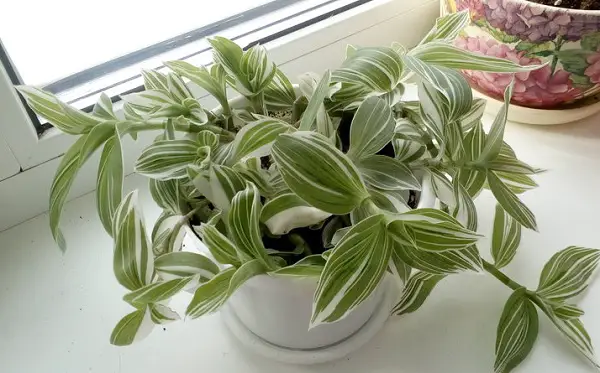
Features of tradescantia
All varieties of Tradescantia are not demanding to care for and are hardy.
The people call the indoor flower with creeping weaving stems “woman’s gossip.”
Lodging lashes quickly take root in the soil, releasing roots from internodes.
Some varieties grow in the form of low bushes with straight branches.
The leaf plates are arranged alternately. The shape of the leaf, depending on the type, is elongated-ovate with a sharp tip, elliptical, or lanceolate. Plants with small green leaves are more common, but variegated (variegated) varieties also exist.
The flowering period lasts 3-4 months. Inflorescences form in the axils of the leaf plates or at the tops, the buds open alternately. Small three-petal flowers in green cups are collected in inflorescences. Delicate shades of petals (from white to lilac) are enlivened by bright yellow anthers on long stamens.
The flower blooms for just one day closes in cloudy weather and at night. The inflorescences attract insects (including bees), although they are odorless.
In place of the pollinated flower, a box with oblong seeds is formed.
Tradescantia varieties and Types with photos and names
The species diversity and endurance of the plant allowed breeders to develop many varieties with highly decorative qualities.
Tradescantia Anderson (Tradescantia x andersoniana)
This species was named after plant breeder Edward Anderson. Securing the beneficial qualities of the Virginia Tradescantia, he brought out a whole group of hybrid plants with a variety of flower colors:
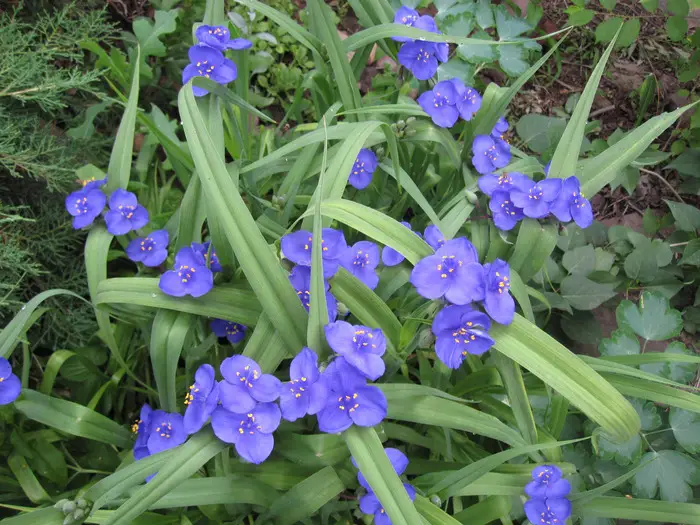
- variety “Alba” – with snow-white flowers;
- “Carnea” – with pale pink;
- “Hutchinsonii” – with pale blue;
- “Coccinea” – with purplish red;
- “Caerulea” – with azure blue;
- “Leonora” – with lilac or violet.
The plant is planted in personal plots. A bush with straight stems and lanceolate leaves grows rapidly, reaching a height of 50-60 cm. A pair of flowers opens on each stem in the morning. There are many stems, and the bush is strewn with graceful delicate flowers.
White-flowered Tradescantia (Tradescantia albiflora)
A common culture with large ovoid leaf blades. It blooms rarely; flowers are small, flat, white. Another name is tricolor.
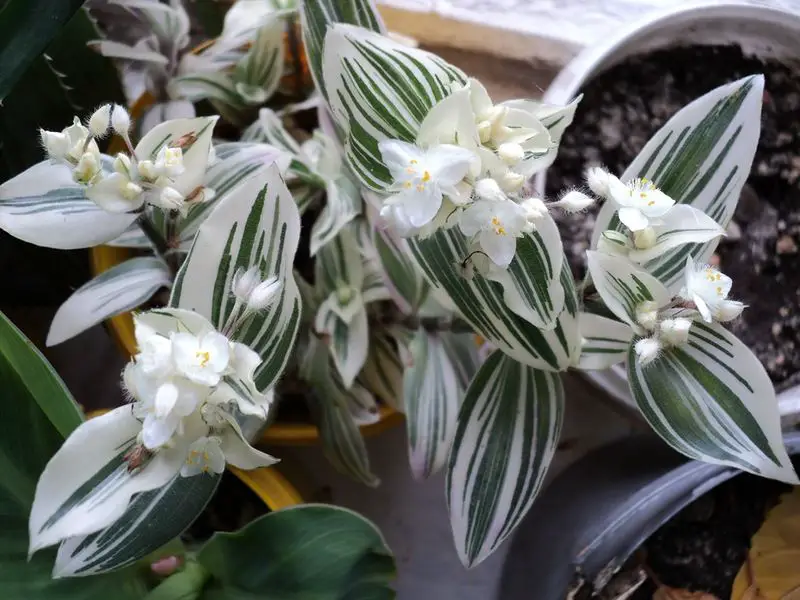
Varieties differ in leaf color:
- Tricolor has white, pink and lilac stripes;
- “Albovittata” – the leaf is speckled with thin white stripes;
- “Aureovittata” – with wide golden stripes;
- “Aurea” – yellow leaves with green stripes on them.
The culture can withstand a drop in air temperature to + 6 ° C and can endure winter in the southern zone of Russia.
Blossfeld Tradescantia (Tradescantia blossfeldiana)
Liana with large leaves and juicy creeping stems. Elliptical leaves are green above with a red tint; the lower part is purple.
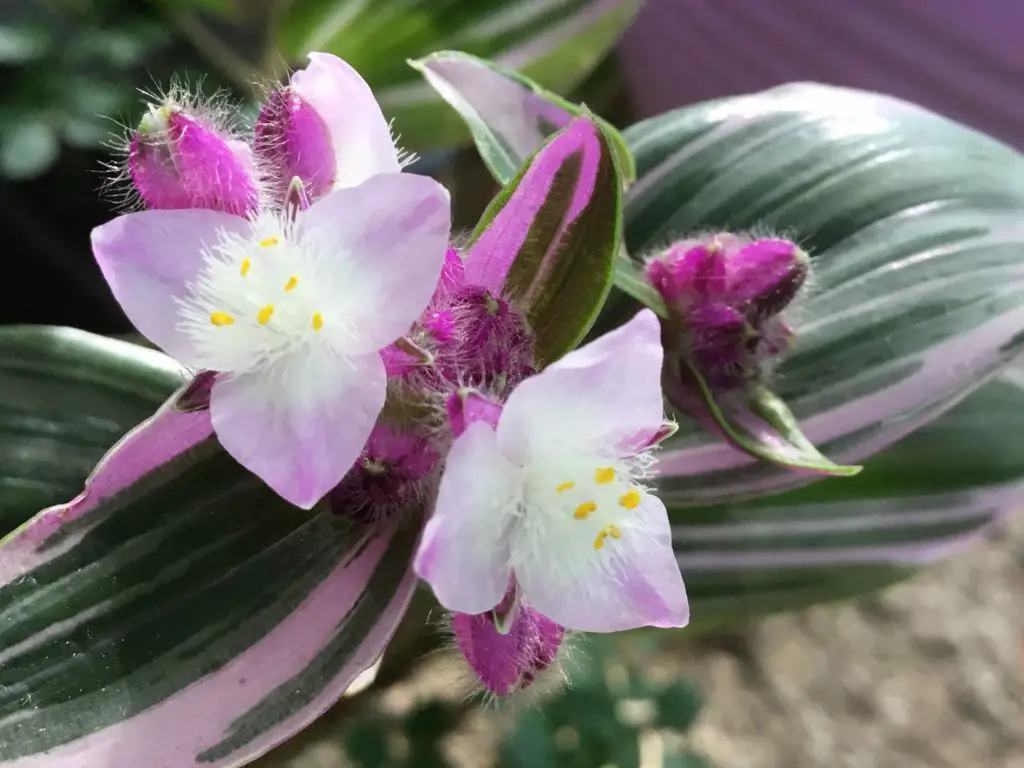
The variegated variety is distinguished by its original coloring: the creamy green foliage is set off by a pinkish bloom. The pattern on the adjacent right or adjacent left leaves is repeated, and the patterns of the right and left leaves are always different.
On the surface of leaves, twigs and sepals there is pubescence – thin white hairs.
Virginia Tradescantia (Tradescantia virginiana)
The progenitor of many varieties, brought to Europe from the southeast of North America. The stem is low, branched. The leaves are narrow, lanceolate.
Blooms are plentiful in the summer months. The flowers are large, purple, bright blue or pink. Closing at night, the flower under the influence of enzymes turns into a jelly-like transparent drop. Therefore, the people called him “Widow’s Tears”.
Due to its endurance and resistance, the perennial retains its decorative qualities both when grown at home and in the open field.
Tradescantia pilosa
This variety is rare. A distinctive feature is dense pubescence, which protects from the bright sun and helps to conserve moisture. All parts of the plant are wrapped in long white hairs. The flowers are pink or pale lilac.
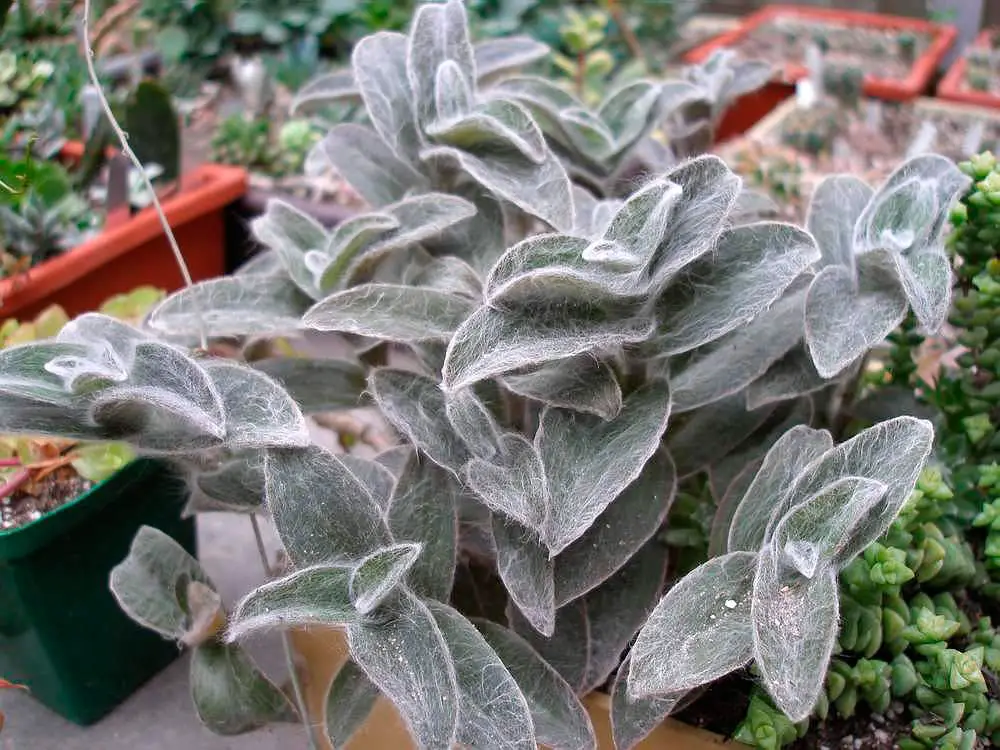
The furry protection allows this variety to be grown on the south side of the house.
Zebra tradescantia (Tradescantia zebrina)
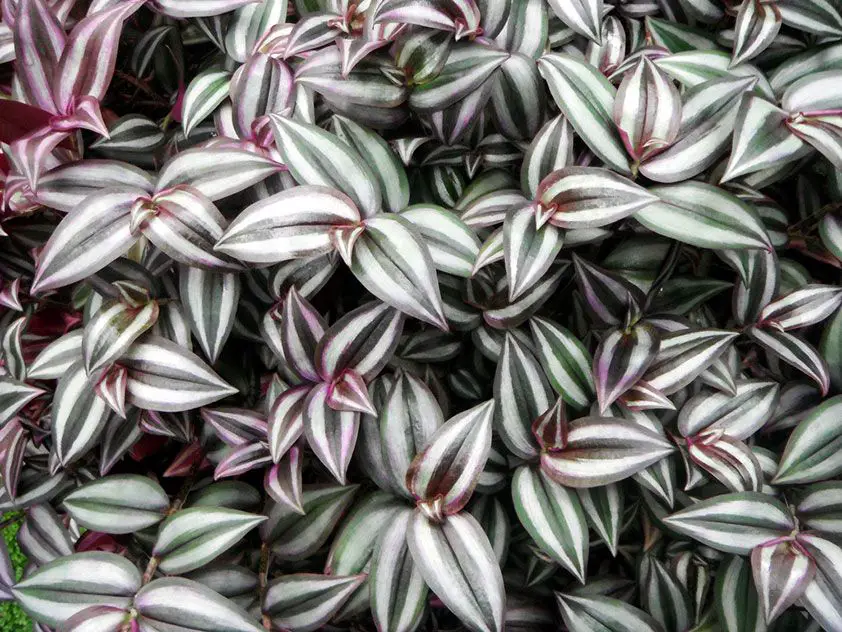
A plant with large leaf blades and a creeping stem. On the front side of the green-lilac leaf plate, there are two wide silver stripes.
The lower part of the foliage, stems and twigs have a reddish tint. Small pink or lilac flowers gather in small inflorescences.
This type of botany was ranked as a succulent. Thickened medium-sized leaves sit tightly on short fleshy stems. The shape of the leaf resembles a boat; many purple dots are scattered along the edge and bottom of the plate.

Grows well on clay and sandy soils.
Tradescantia multicolor
Variegated culture with green leaves covered with white and pink longitudinal stripes. Spectacular appearance and easy maintenance are often used when decorating industrial premises.
Tradescantia fluminensis
Variegated herbaceous vine with thin flexible stems. Small ovoid leaves are painted with light stripes of different widths. The branches, as well as the lower part of the foliage, are purple in color.
This flower looks good next to the aquarium. Hanging greens are happily nibbled by aquarium fish.
Growing Tradescantia
Any kind of Tradescantia can be grown without too many problems. Most of them do not tolerate cold weather, however, varieties have been bred that can overwinter in the open field at a temperature of + 5-6 ° C.
The herbaceous liana grows as a ground cover, but is more often used as an ornamental ampelous plant. She gets along well with other cultures.
Tradescantia is bred in greenhouses, conservatories, offices and apartments.
Planters suspended on brackets look spectacular. Hanging and intertwining, flexible twigs adorn a wall or balcony.
If you plant an unseasoned houseplant in a flower bed, it will quickly lose its attractiveness. The leaves become weathered and thinner, the shoots suffer from insect pests.
tradescantia care
With the vitality of the plant, it is still better to follow the basic rules of care and maintain comfortable conditions.
Lighting
A tropical flower prefers diffused light, it is better to place it on the east or west side.
The sun’s rays in the morning or evening will not harm, but the midday summer sun is dangerous, burns may appear on the leaves.
You should not put the flowerpot on the windowsill of the south side, it is better to hang the planter at a distance of 1.5-2 m from the window.
Variegated varieties require more diffused light; in the sun the leaves become thinner and wither.
Temperature regime
In spring and summer, a comfortable temperature for a plant is + 25-26 ° C. It is useful to ventilate the room, avoiding drafts. You can take out the pots to a glassed-in balcony or loggia.
For wintering, it is better to provide a temperature of + 10-12 ° C, then the lashes will not stretch. If the tradescantia hibernates in the room, you need to increase the daylight hours with the help of backlighting.
Watering
With the beginning of the growing season, it is required to water the flower regularly, preventing the clod of earth from drying out. The liquid from the pallet should be poured out. By the end of the growing season, the frequency of watering is reduced to 1 in 5-7 days.
In winter, during a period of relative dormancy, it is enough to just slightly moisten the soil. Tap water must be settled or boiled, then cooled to room temperature.
Air humidity
The ancestors of indoor tradescantia are tropical plants, so spraying with a spray bottle and bathing in the shower are beneficial in spring and summer. Liana grows even at a low level of humidity, it is enough to wash off the dust monthly.
Fertilizer
At the end of March, it is recommended to start feeding the plants with organic or mineral fertilizers. Until September, you can apply top dressing once every 10-12 days, alternating between different types of fertilizers. Variegated species are not fed with organic matter.
Pruning
It is better to form a bush in the spring during transplantation. Old branches are removed, on which leaves grow only at the tops.
Young shoots are pinched to develop lateral processes. This can be done throughout the growing season.
Transplantation of tradescantia
The young plant is transplanted annually in the spring. After 3-4 years, it is better to replace Tradescantia.
The soil mixture is prepared from deciduous soil (4 hours), turf (2 hours), leaf humus (2 hours) and coarse river sand (1 hour). The soil should be pre-calcined in the oven for 30-40 minutes.
Broken brick or expanded clay is suitable for drainage.
The pot must be chosen small, but wide, since the roots are actively growing to the sides. If there is no drainage hole at the bottom of the pan, you need to make one yourself.
Virulence
Pale Tradescantia is considered a dangerous variety. Its juice causes irritation and flushing of the skin. On contact with the mucous membrane of the eye, there is a burning sensation and lacrimation. It is better to transplant or pinch such a bush with gloves. After handling, wash your hands thoroughly with soap or gel.
Propagation Tradescantia
It is recommended to plant Tradescantia in late March or early April.
Growing from seeds
Seedlings from seeds are grown in peat pots or disposable cups with a peat-sand mixture. Cover the top with a transparent bag or a cut plastic bottle.
The mini-greenhouse must be regularly ventilated, otherwise the soil will become moldy. A seedling grown in this way will reach the flowering stage only after 3 years.
Cuttings
This is the easiest and most reliable way. Stems 10-15 cm long are cut from the old plant and planted in pots of 5-6 pieces. You can get cuttings by cutting a long vine into pieces.
It is necessary to compact and water the soil, then transfer the flower to the window, covering it from direct rays. You can stick a film on the glass or close it with a sheet of paper.
The cuttings will take root in 1.5-2 weeks; lateral shoots will appear in 2-3 months.
If you put the cut stems in water, they will sprout and even grow, you just need to change the water regularly.
Reproduction by division
Sometimes the roots grow, filling the entire container. It is necessary to moisten a clod of earth, carefully divide the rhizome into 2-3 parts (you can cut it with a blade). Then place each part in a separate container with earth and pour over with lukewarm water.
Tradescantia problems
Tradescantia is rarely sick. Help will be effective if signs of damage are noticed immediately and adequate measures are taken. Observing the plant every day, you can see the following negative changes:
- the growth of vines slows down, the shoots become pale and thin;
- the leaves dry out at the edges and acquire a brown tint;
- yellowish spots appear on the leaf plates;
- the whips stretch out, the foliage dries and flies;
- leaves of variegated varieties acquire a monochromatic green color.
The reasons are most often errors in care: insufficient light, lack of nutrients and moisture, improper pruning. If a positive result is not achieved by rearranging the flowerpot, enhanced watering or feeding, it is better to cut fresh cuttings and grow a new bush.
Diseases and pests
Excessive moisture can lead to rotting. First, the roots rot, and then the stems. Proper watering and drainage will help prevent root rot.
On an indoor flower, thrips, spider mites or scale insects can grow. The main pests of Tradescantia in the garden are slugs and aphids.
With regular inspection, you can notice the pests themselves or signs of damage: the leaf plates fade and deform, spots appear on them, the growth of shoots slows down.
At the first sign of infection, you need to rinse the leaves with a solution of laundry soap. If this does not work, an insecticide should be used.
